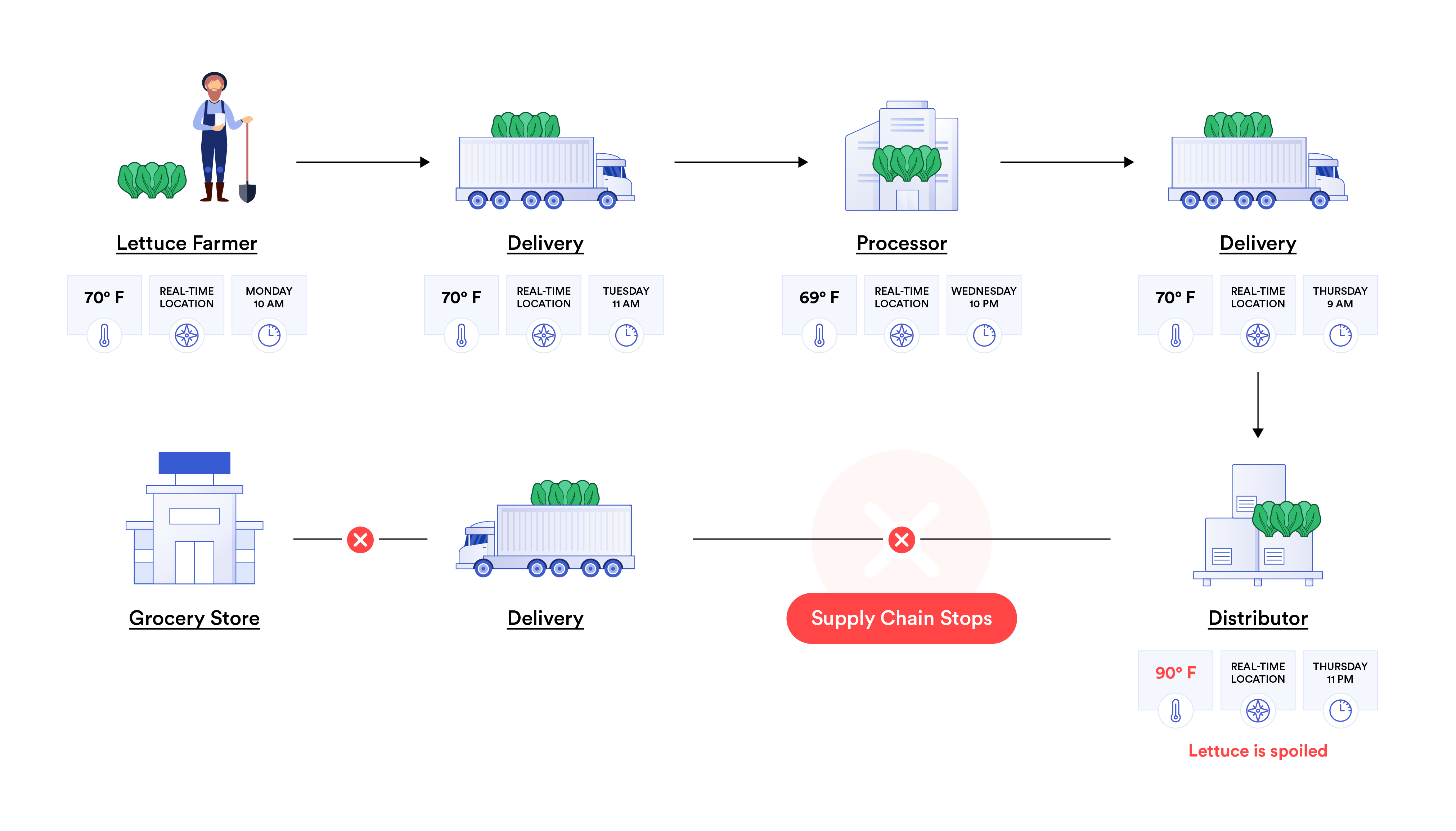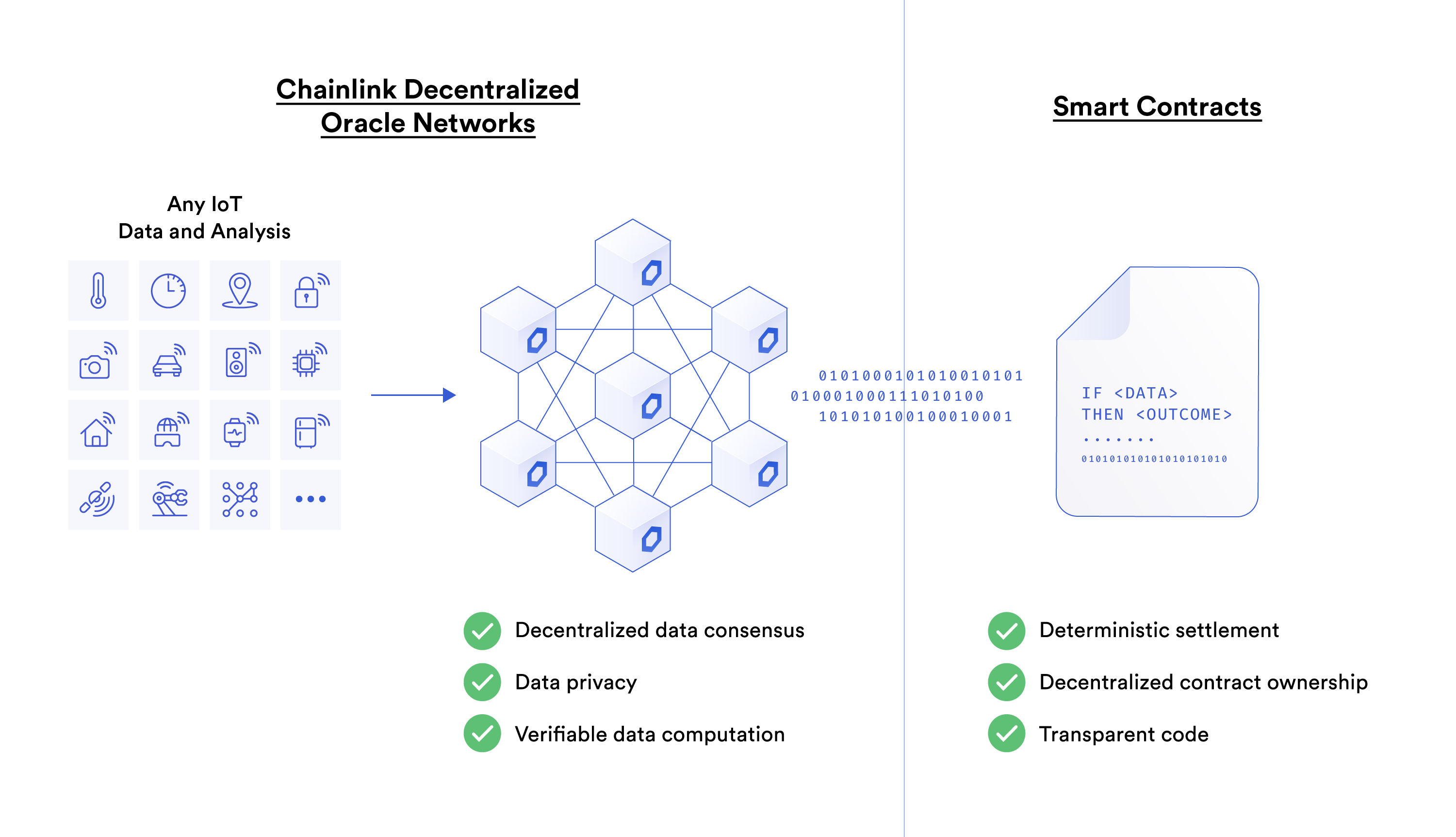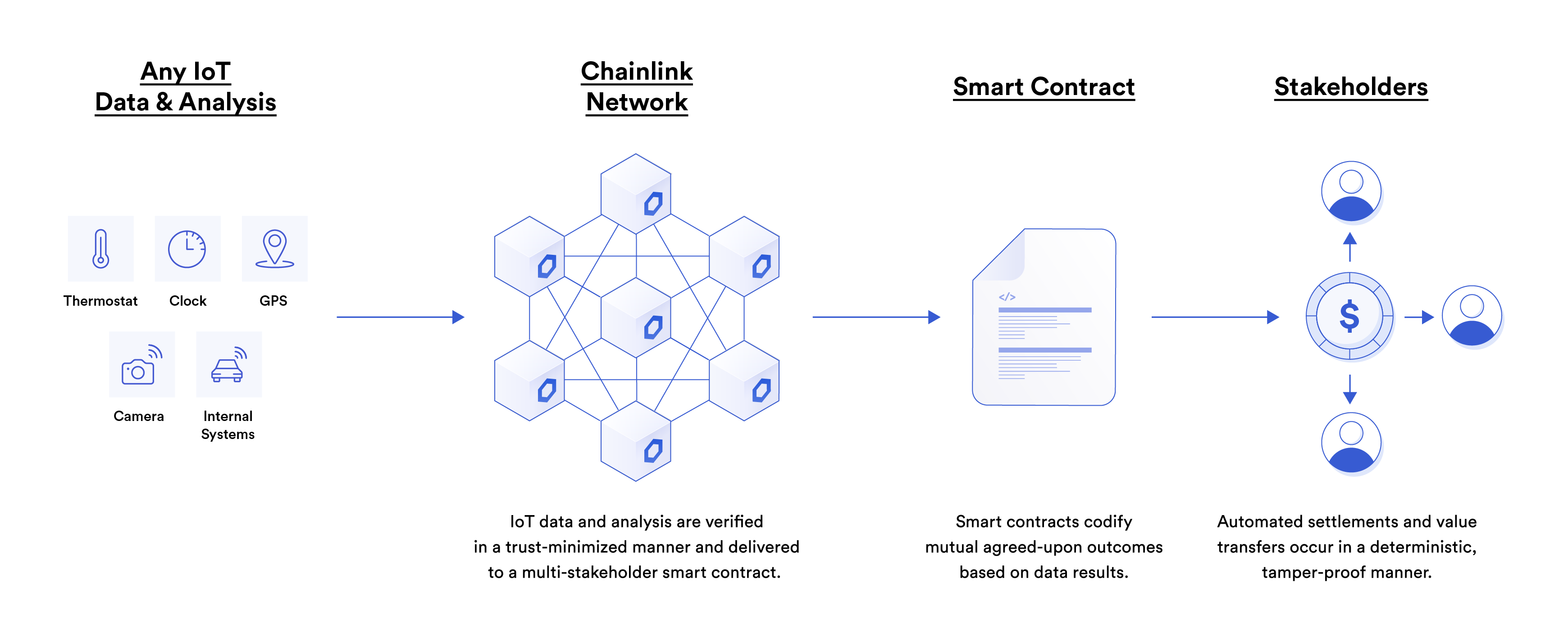How Blockchains and Oracles Are Accelerating the IoT Economy
The development of the Internet is continuing at an incredible pace . The past two decades have seen an unprecedented growth in connectivity that has enabled society to communicate at high speed across all corners of the globe, participate in public forums and interact with billions of individuals, and transfer money electronically in seconds. But what’s next for the Web?
Many anticipate that connected devices will play a huge role in the next online epoch, a development often referred to as the Internet of Things. An huge number of electricity-powered objects are currently already connected to the Internet or are in the process of being brought online, enabling them to send and receive data in machine-to-machine communication and take preprogrammed and autonomous actions that would have otherwise required manual control.
There are a massive range of use cases for such online devices: smart thermostats that sense your phone’s GPS location to begin cooling down the house; autonomous sprinklers that water the grass after you’ve left for work to avoid wet roads or unnecessary accidents ; cameras that turn on and record when they sense movement, or trigger alarm systems and call the police during break-ins. In the past, these kinds of devices were considered a fantastical vision of what technology and the Internet could do. Today, some of these functions are considered mundane and ubiquitous. However, the true Internet of Things is just getting started.
A High-Level Breakdown of IoT
In addition to an Internet connection, IoT devices require three components.
Sensory Devices
Sensory devices are exactly what they sound like—devices that sense certain physical phenomena. This is the temperature-detecting component of a thermostat, the device that measures soil moisture for an autonomous sprinkler, the movement detector for a camera. These devices provide the “trigger” conditions for autonomous action.
General Devices
Whether a thermostat, a fridge, a lightbulb, a camera, or a warehouse manufacturing robot, general devices refer to the physical machine that performs an action based on a sensor’s data. These devices almost always provide a particular service that must be executed under certain conditions. They are at the heart of the Internet of Things—taking the vision of an interconnected ecosystem of machines beyond the simple exchange of data.
Backend Storage and Processing
Backend storage and processing refer to the data, Web server, and data analysis platforms that are steadily expanding what IoT devices can do and making the widespread interconnection between devices possible. These platforms store the data provided by devices, power insights that can make devices smarter and better, and send relevant data and data insights to stakeholders in easily readable formats.
Automating the World With IoT
This combination of sensory devices, general devices, and backend storage and processing is already making manifest the vision of full automation.
For example, sophisticated machinery already exists to isolate unripe, green tomatoes from fully ripe tomatoes in agricultural production. The sorting device (general) uses a combination of optics and light (sensors) and computer software (processing) to remove green tomatoes from the rest of the harvest in a strikingly accurate manner—completely removing manual labor from what was once a labor-intensive process.
Examples like these generally exist in closed silos. The tomato sorter could work in tandem with automatic packaging machinery that divides the tomatoes into specific weights and packages them for delivery. The packaged tomatoes could be automatically sorted into various boxes meant for different destinations. An Internet connection and a processing backend could connect different machines to trigger different actions based on the supply chain process. This is generally the limit of IoT today. However, the process after leaving the facility and transferring ownership to another stakeholder in the supply chain presents a unique challenge—continuing the automation process across stakeholders.
The emergence of a true IoT promises the ability to minimize human intervention or analysis when machine-to-machine communication should suffice. As technology becomes more advanced and more machines become fully autonomous and connected, the limitations come not from technology, but from society and its need for trust.
The Limitations of the Current IoT Ecosystem
The usefulness of IoT data and insights begins to diminish when automated systems need to incorporate multiple stakeholders and attribute liability in the case of process failure.
Consensus on IoT Data and Insights
In many cases, these shared systems—which can come in a variety of forms—fail to utilize IoT devices to their highest capacity because there is not an established way to achieve consensus on the data and the insights it provides.
For example, a California-based farmer owns a lettuce farm, with the lettuce the farmer produces ending up in grocery stores around the country. However, the supply chain from farmer to the end consumer has multiple stages—from the farmer to the processor to the distributor to the grocery store to the end consumer—and at each stage, the lettuce can potentially become spoiled due to negligent storage.
Knowing exactly when, where, and in what conditions the lettuce became spoiled is critically important to knowing which party is at fault and subsequently determining the payment flow. IoT devices, data, and platforms can provide this data at low cost. For example, by placing temperature sensors in trucks and within storage facilities spanning from the farmer to the grocery store alongside traceability solutions, much-needed insight to make these systems more automated and fair can be gleaned.

However, IoT devices and backend systems that are mainly controlled or paid for by a single party create skewed incentives and introduce the ability to manipulate the data. For IoT devices and data to be truly useful in building a more equal business environment, there must be a way to record and solidify both the IoT data and the insights parties take from it in a transparent and undeniable manner so the results cannot be contested.
Automated Value Settlements
Another functionality necessary to unlock the full vision of IoT is the ability to automatically settle value transfers between multi-party stakeholders.
For example, local farmers have fewer resources and capital than large processors, distributors, and grocery chains. While the latter entities might be able to sustain long-lasting disputes, delayed payments, and other consequences, local farmers generally cannot. These imbalances exist in many supply chains and business processes in general.
In order to create a level playing field based on accurate data provided by IoT devices, there must be a way to tie IoT data directly into an automated settlement system so that larger players cannot abuse their disproportionate advantages in resources, influence, or both. In shared systems, IoT data is only as useful as the outcomes generated and guaranteed by the data and its insights. Mitigating the ability of bad actors to overcome the system in other ways is integral to making this technological revolution fairer for all.

IoT Without Limitations
An easy way to think about these limitations is to imagine what is possible when these missing pieces—data consensus and automated settlement—are solved. In the previous example of a farmer to grocery store supply chain, temperature sensors, GPS equipment, and smart cameras can already provide the when, where, and how of any spoiled lettuce. However, these missing pieces would make this data transparent, time-stamped, verified, and deliverable in real-time to all stakeholders in a way that’s impossible to manipulate—providing a critical source of consensus on the data.
Liability would then be assigned to the stakeholder in charge of storage at the time of spoilage, and an automatic settlement system would compensate those negatively affected by the food spoilage in a manner encoded into the shared system. No stakeholder, not even the party liable, could stop the value outflows: Everything in the process would be set in stone using verifiable data as a shared source of truth. The potential for this type of automated settlement system based on real-time data is huge, limited only by how granular, accurate, and autonomous IoT devices can be.
Consider a futuristic case where every single car is capable of autonomous driving and linked to the Internet. A person calls an autonomous car to pick them up, which automatically holds a payment deposit when it arrives with the passenger. The car heads to its destination, taking the fastest path as informed by the collective data on every car’s destination and path. Once at the destination, the payment to the car owner is deterministically settled by calculating the system’s operational costs, the car’s electricity/gas costs, and the predetermined service fee—all available to both owner and buyer on-demand.
Smart Contracts and Oracles: the Missing Pieces
Building data consensus and automated settlement systems for IoT devices is not an easy task. In order to create truly robust systems, there needs to be a way to decentralize the data at every step to match the value of the process being secured and the stakeholders at play.
For example, multi-million dollar processes for managing large supply chain shipments may need stricter security and decentralization requirements, as the value being secured is high. This means everything from the data device itself to the fetching, processing, and delivery of the data should have measures of decentralization that protect stakeholders against manipulation at every stage. On the other hand, low-value ridesharing platforms may be able to make some tradeoffs as each individual transaction is lower in value. However, all multi-stakeholder processes and value transfers will require automatic settlement so that no stakeholder can censor or evade the preprogrammed outcome.
As immutable pieces of autonomous code built on top of blockchains, smart contracts make up the first missing piece of the puzzle by offering the deterministic execution of if-then processes. If the lettuce has been spoiled in the processor’s warehouse, then a pre-agreed amount of funds is automatically withdrawn from the processor’s bank account and given as compensation to the farmer. If the car has arrived at the destination, then a deposit is automatically transferred from the requester’s bank account. These preprogrammed, immutable contracts cannot be changed or stopped by any entity or stakeholder once every party has willingly agreed to participate. They are the basic building blocks for creating a cross-stakeholder, IoT-based system.
However, blockchains and the smart contracts built on top of them are unable to natively communicate with the external world, including IoT data and processing systems. This presents a significant roadblock to incorporating automatic, deterministic settlements into multi-stakeholder systems based on IoT data and insights.
Additionally, if data insights—as opposed to raw data—are used to trigger settlements, the computation of the data itself must also have some form of transparency and verifiability to foster confidence and trust between stakeholders. An example of computation is the final payment an autonomous car owner makes to a ride requestor. It’s not enough to just input raw data for the smart contract’s operational cost, IoT-device generated gas/electricity costs, and service fees, there must also be some form of computation to accurately come to the final value—and verification of that computation to ensure complete transparency and accuracy across all stakeholders.

How Oracles Bring Smart Contracts to Life
Chainlink is the industry-standard protocol for bridging the gap between smart contracts and the external world. Chainlink provides smart contracts with secure and reliable access to off-chain data and computation, serving as a critical form of trust-minimization that can unlock the full potential of IoT.
The Chainlink Network accomplishes this through decentralized oracle networks—groups of sybil-resistant and highly reliable node operators that independently fetch data, perform computations on it, and then come to a consensus that is then delivered to the smart contract. Additionally, these decentralized oracle networks are compatible with any individual blockchain platform, enabling IoT-based smart contracts that can exist on any blockchain or interoperate across multiple chains.
Decentralized oracle networks (DONs) perform the trust-minimized data delivery, processing, and computation necessary to fulfill the vision of an automated world.
- Data Delivery—Whether it’s data from individual IoT devices, a collection of redundant IoT devices to minimize hardware centralization risk, or backend platforms, Chainlink oracle networks are secure middleware for delivering data on-chain in a reliable, timely, and secure manner.
- Data Processing and Computation—Chainlink DONs are constantly evolving to provide more trust-minimized guarantees on computation. This means that when analysis of raw IoT data is needed to automatically settle values through smart contracts, Chainlink DONs can both verify the IoT data and perform verifiable computations to help ensure an accurate result.
- Data Privacy—A feature being worked on within the Chainlink Network is the ability to verify data without revealing the data itself through zero-knowledge proof technology such as DECO. This enables firms to hide the underlying data while proving that a specific aspect of it (i.e. that the temperature of the lettuce was below 70 Fahrenheit) is true.
Additionally, Chainlink decentralized oracle networks aim to operate as a blockchain abstraction layer that enables existing backend processing systems to seamlessly integrate with, and participate in, IoT-based smart contracts. This helps expand the design space for underlying smart contracts in a few ways. Chainlink can help provide the same trust-minimization guarantees on data insights provided by third-party platforms as it can on the raw data provided by IoT devices and offer an abstraction layer that enables backend systems to read and write to smart contracts in a seamless manner. Each decentralized oracle network can be customized to match the needs of the stakeholders and their preferred system.

To understand this in a more tangible way, let’s go back to the example of the lettuce supply chain. All nodes within a customized Chainlink decentralized oracle network can independently monitor the IoT devices across the supply chain and then trigger a response to the smart contract when the lettuce is spoiled with a note on the timestamp, temperature, and location.
Chainlink nodes are financially incentivized to provide an honest response, and only when a specified and customizable consensus—for example, more than 80% of nodes must respond with the same value and conclusion—will the data be delivered to a smart contract and trigger a variety of value transfers (i.e the liable party paying stakeholders for their operational costs). If an existing supply chain is already operating collectively using a third-party platform for data analytics, it can also be seamlessly integrated and trust-minimized. Additionally, Chainlink nodes can directly connect to IoT devices on a 1:1 basis or through a larger server, providing additional customization at the node level to build more tailored and secure DONs.
In essence, Chainlink decentralized oracle networks can help provide a valuable form of trust-minimization for IoT data and data computations to help power a cryptographic source of truth needed for stakeholders to trust the value transfers that occur in a smart contract. Smart contracts and the constant advancements in IoT technology and devices are two key elements necessary to build a truly automated world. Chainlink decentralized oracle networks are the missing link—securely connecting these elements to deliver a trust-minimized source of truth on all relevant data and insights to smart contracts.
The End Game of IoT
Devices are only getting smarter. Whether it’s the physical capabilities of the machines themselves, the granularity of the sensing devices, or rapidly advancing machine learning and artificial intelligence guiding autonomous decisions, the vision for a fully automated world is slowly coming to life.
It’s possible to imagine the augmentation of legal contracts with smart contracts informed by every instance of relevant data. A housing smart contract that uses IoT devices to record damages to a rented house, automatically draw from security deposits, and book an appointment for the right personnel to come and fix the problem; a precise AI-powered camera that determines liability and triggers automatic settlements between blockchain-based insurance firms and policyholders in the event of a car crash, and then signals for an autonomous truck to pick the car up for repair; a privacy-preserving smartwatch that pays wearers for their medical data, monitors how the data is used and where it goes, and books hospital visits when necessary.
The true potential of IoT devices and data lies in their ability to autonomously take action based on an undeniable source of truth and increasingly sophisticated analysis of data. Machines and systems always do exactly what they are programmed to do. The trick is creating truly immutable machines and systems that operate independently of any one stakeholder’s desires and fairly execute actions and value transfers using a shared source of cryptographic truth.
